Handicap Matches Scoring Results
By Strokes Galore
12 Minute Read
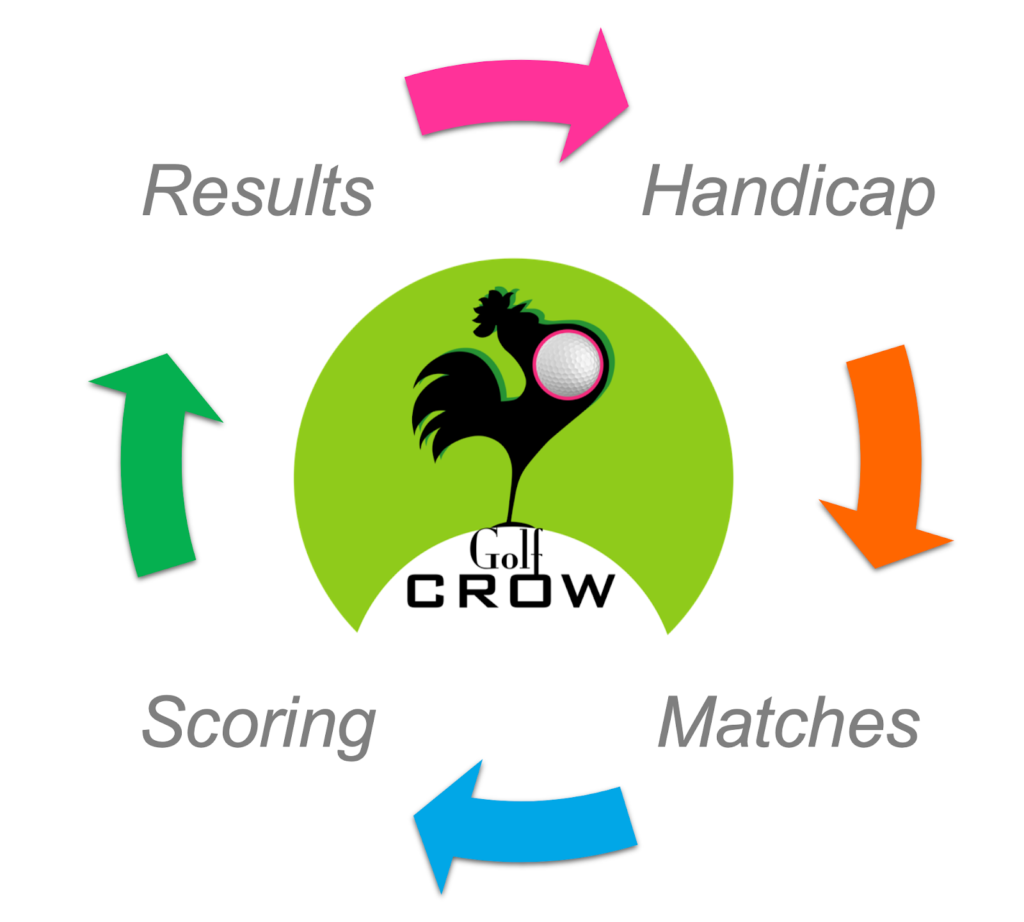
The circle. Image credit: Megawagt
The Golf Circle of Life!!!!
Traditionally, the circle of life describes the cycle of procreation, birth, life, and death. One life leads to the next. In golf, some might argue the circle is wake up, play golf, eat, sleep, repeat – one round leads to the next. But the golf part, and the beauty of golf for those who like to compete, is the equitable process that enables players of varying ability, even widely varying, to go head to head.
It’s a phrase that popped years ago, probably on the range warming up, when I had the good fortune to be at a golf course 4 to 5 days a week. This was a private country club, where almost every round includes a money game, and your handicap is paramount in setting the playing field, basically determining how many strokes you’re giving or getting.
And the matches, the competitions, well at this place usually a game called “7 Ways”. It actually took over a year, mostly paying out, to discover what 7 Ways stood for. Story for another time.
Now scoring, as in any sport, drives results. In golf however, the results feed back into your handicap, and the cycle begins anew the next time you play, hence the circle.
Handicap – Your Golf Identity

The little things matter
Official golf handicaps are calculated by a governing body like the USGA (United Stated Golf Association) using the GHIN (Golf Handicap Index) system
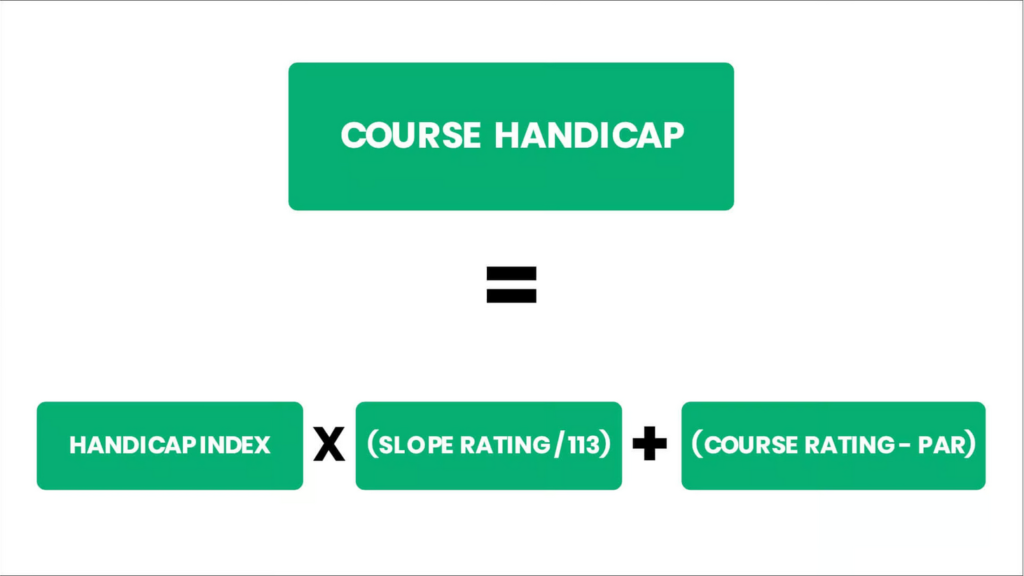
Made with care
GHIN spits out a one decimal place number (Handicap Index) that then converts by formula to a rounded whole number (a Course Handicap)
If there’s one term that defines any self-respecting golfer, it’s handicap. This is the number that signals to another golf nut, “how good are you?”
Single-digit Handicap Index values (less than 10.0) cover good to very good, the lower the better, with 0.0 or “scratch” firmly in awesome territory and lower numbers, expressed as plus e.g. +1.4 being exceptional. Scratch or “plus” golfers expect to shoot around par or better. Double-digits on the other hand run the gamut from average to poor, the higher the number the worse you are expected to score. The overall range runs from +9.9 (best possible) to 54.0 (worst). A catch all where the majority reside is the “bogey” golfer, averaging one over par per hole.
Quick par explainer, for newbies. Par is the number of strokes a good golfer is expected to complete the hole or round in. Depending on distance, holes typically span par-3 (shortest), par-4 (most holes) and par-5 (longest) with par for an 18-hole course totaling around 72 (an excellent, ideal score in most settings).
Other inputs required for a Course Handicap depend on the course and tees you’re playing from and include slope rating, course rating, and par. Luckily, there are calculators available so you don’t have to do the math yourself. Armed with a Course Handicap one can now determine the strokes you’ll be giving or getting in whatever match you decide to play. Simply take the difference in course handicap between two players, apply it to the hardest holes and presto, the bogey golfer can take on the scratch.
“With enough strokes, almost anyone can beat even Tiger Woods. But how many will you need? That’s where the handicap comes in.”
– Alfred S Bagger
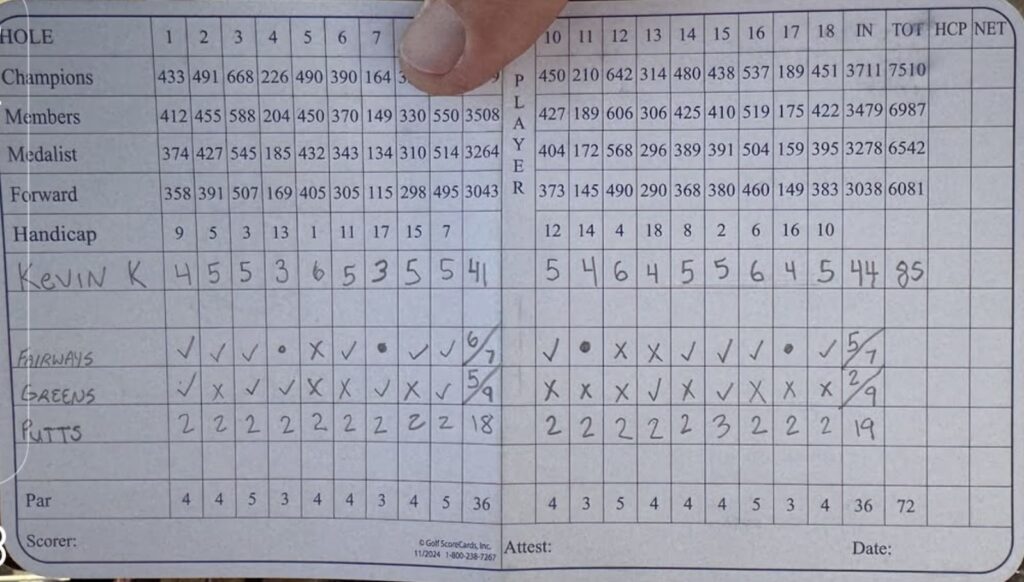
Huh? Stats? Where is the match? Isn’t that what really matters?
Let the games begin!
Matches – Where Handicaps
Come to Life
Golf matches, the games we play, trying to take each other down. Will you come out ahead or be paying out? It definitely gets the juices flowing. Put a little action on the round, have some fun. It’s also a terrific incentive to improve or else find your wallet getting progressively lighter. These contests take multiple forms but are generally classified into stroke play or match play. In stroke play the lowest number of strokes across all holes wins (how pros compete, no handicap necessary), while in match play it’s who wins the most holes. Each hole is its own competition, with net strokes (gross strokes – handicap strokes), determining win, lose or tie. While stroke competitions certainly have their place and often include gross and net prizes, match play is more prevalent and forgiving (a bad hole or two won’t necessarily bury you). Match play head-to-head competitions emphasize strategic decision-making over simply shooting the lowest score. It’s how most groups compete day in and day out. As a result, there’s rich variety across match play.
Stroke Play – add up the strokes, lowest number wins, gross and/or net categories.
Match Play – low net stroke total wins a hole, most holes won wins the match. In addition to an Overall match (across 18 holes), division into Front 9 and Back 9 matches and “Presses”, a new match for the remaining holes, are commonplace. Variables like Junk, Doubling, Combined scores and partner switches inform more games, adding to the mix.
Classic Match Play games include Nassau (front/back/overall), “Ways” games (Nassau variants with weighted front/back/overall values), Captains, Closeout and Sixes Round Robin.
Examples:
- Straight $5 Nassau means $5 Front, $5 Back, $5 Overall
- 5/5/10 Nassau means $5 Front, $5 Back, $10 Overall
- $5 7 Ways (2/2/3) means $10 Front, $10 Back, $15 Overall
- $5 5 Ways (1/2/2) means $5 Front, $10 Back, $10 Overall
Points-based matches, a subset of match play, offer more options. Earn points for various accomplishments/outcomes, most points wins. These matches can pay out on straight point differentials or have points decide front/back/overall amounts. Points-based games include Stableford, Skins, Wolf, High Low, Chicago, Junk, Sixes Round Robin, Vegas, Chicago, Nines, Sixes and more.
Another key in matches is format. Are you playing individually or as part of a team? Sometimes it’s both, you have a team match (you and a partner vs another team) and one or more individual aka “indie” head-to-head matchups. Team pairings can remain fixed for the round or fluctuate based on the game.
While most games may involve between 2 and 5 players some only take place with a fixed number of players specific to 3, 4 or 5-player groups.
Examples:
- Nines and Sixes are 3-player games
- Wolf has a 3-player minimum
- Sixes Round Robin, Vegas, and High Low are 4-player games
- Captains is a 5-player game (3 team matches, up to 10 indies)
Whatever the setup, match play captures golf’s essence, balancing fairness with competitiveness, making the game engaging regardless of skill level.
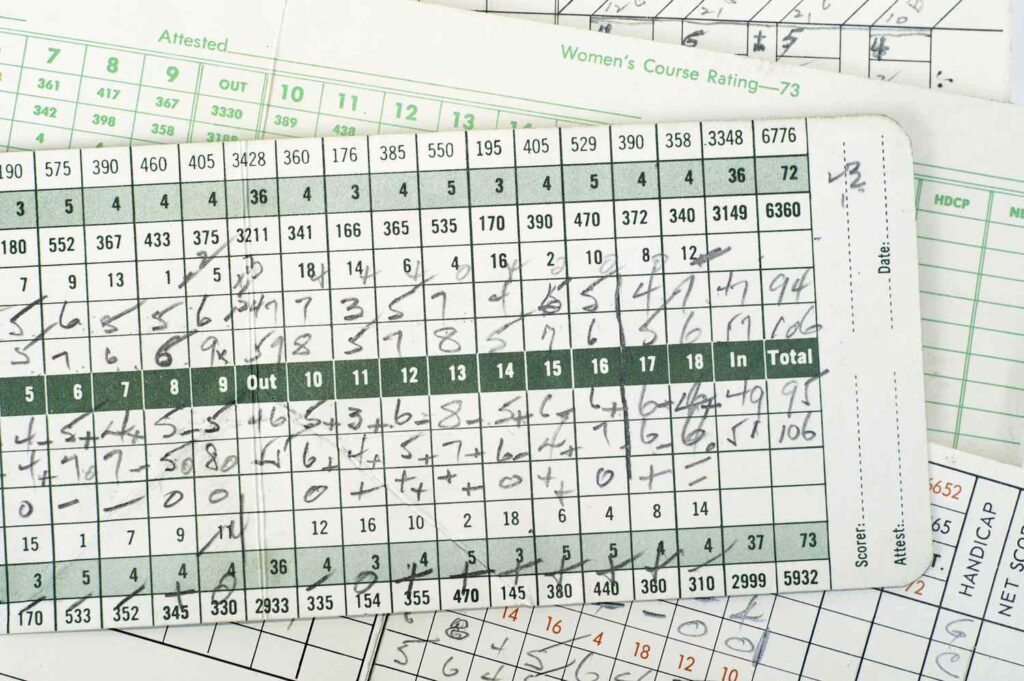
Ancient Egyptians had nothing on us!
Scoring – How are we doing?
Hole Score and Match Score
Scoring, keeping track of the round, starts with how many strokes one takes to complete a hole. The minimum, perfect, although highly unlikely number is one stroke. At the far end of the spectrum is the maximum number of strokes, currently set as net double bogey (par + 2 + strokes) for handicap purposes. In terms of a match, however, net score (gross score minus strokes) determines hole outcome, irrespective of the max arrived at by formula. When playing matches there’s also the all important concept of match score, how many holes up or down are you?
Hole scoring using handicap, standard 18-hole match:
- Joe Bogey is an 18 handicap playing Sam Scratch 0 handicap
- Joe Bogey receives one stroke on every hole
- Joe Bogey wins any hole where he shoots the same as or better than Sam, ties any hole where he shoots one more than Sam, and loses any hole where he shoots two or more worse
- At the end, most holes won wins the match
So despite a terrible hole, Joe taking 8 strokes versus Sam’s 4, Joe only goes down one and it’s on to the next hole. At least until one side or another is up more than there are holes left to play. For example if Sam goes up 3 with 2 left to play, expressed 3 & 2, that match is over. And if you win the last hole in a tied match it’s expressed as 1 UP. See Appendix for the full nomenclature on match score.
Besides an overall 18-hole match the format lends itself to partial-round competitions like a front 9 match and a back 9 match. “Presses”, meaning a new match from the current hole thru the remaining ones, increase the action.
Why presses? Presses add to the action and give players the ability to rally back after a rough start (or conversely fall further behind). Although some may implement presses over an 18-hole overall round and make them at will, most club golfers play the overall without presses and use a more reasonable two hole automatic for each 9-hole match. It opens a new match any time a side goes up or down two holes at half the stakes of the governing 9-hole match.
To track presses, slashes are used by convention to separate the scores e.g. 2/0, 3/1, 4/2/0. The first number refers to the 9-hole match followed by the press(es) in order. With automatic 2-hole presses, one can have up to four different presses in play in a 9-hole frame!
Match score using presses:
- Joe Bogey wins the first two holes, 1st press opens on hole 3, score recorded as +2/0
- Joe Bogey loses the next two holes, 2nd press opens on hole 5, score recorded as 0/-2/0 (front 9 match tied, down two on 1st press)
- Joe Bogey wins the next two holes, 3rd press opens on hole 7, score recorded as +2/0/+2/0 (front 9 match +2, tied on 1st press, up 2 on 2nd press)
- Hole 7 & 8 are tied (score stays at +2/0/+2/0)
- Joe Bogey loses hole 9, score recorded as +1/-1/+1/-1 (won front 9 match +1, lost 1st press, won 2nd press, lost 3rd press
- Back 9 match starts all square and Joe Bogey is up one in the overall match
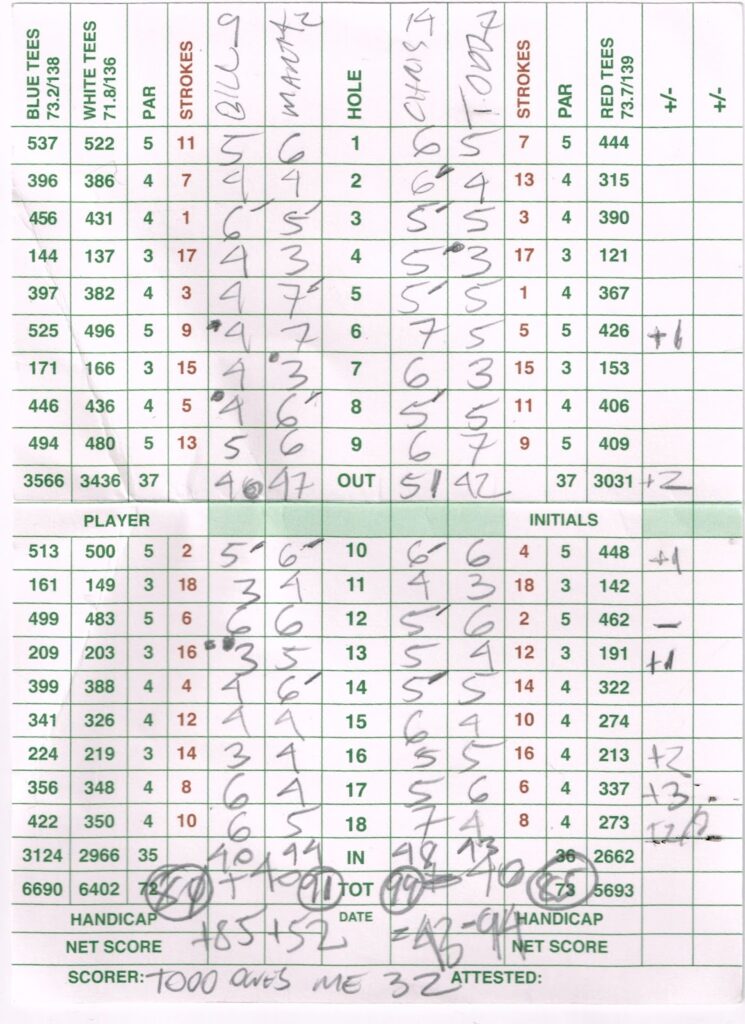
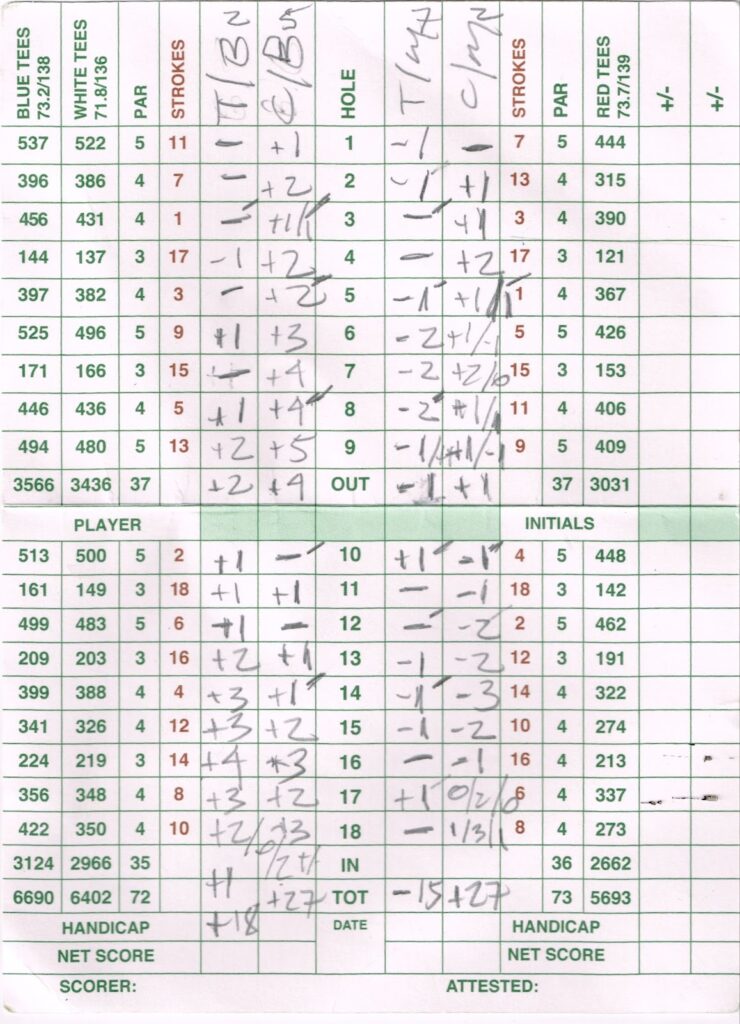
Took two cards to track this match! Todd goes down, no surprise.
Results – Damages and
Posting Complete the Circle
Results, the outcome, did you win or lose, did you shoot a good score? Sadly, the round eventually comes to a close and it’s time to tally the damages and your final score. Hopefully you did well, made some memories and most importantly, had fun. In terms of satisfaction, the best was always winning money and shooting a low score, and believe me the two aren’t always directly correlated.
Either way, keep in mind that course handicap is a great barometer of how someone of your skill level did versus old man par. Take gross score (capped per hole at net double bogey) and subtract course handicap to get a net score and see how far over or under par you were. If the handicap gods are doing their job right, chances are your net will be within a few strokes of par.
To complete the cycle, post your score to the GHIN system or ratings service equivalent and overnight your handicap may tick up or down, ready to be applied to the next round all over again. It’s the best mechanism we have to level the playing for friendly competition day in and day out.
And the money, the damages? Maybe you got a drink or two out of it or earned the caddie fee. Remember it’s the experience that’s priceless, being able to fully participate in this magnificent game.

Why Golf Crow?
Yes, that Golf Crow, sitting inside the circle, why is that?
As you might infer from the Matches section, the money games we played were rather involved, and keeping track of it manually with pencil and paper was arduous and error prone. To the point where it detracted from playing my best. That and select playing partners crowing time and again about how much they took from me.
Golf Crow provides accuracy, saves time, allows sharing and is tailored to smoothly navigate the circle – Handicap, Matches, Scoring and Results:
Handicap – retrieves handicap index given a valid GHIN number, automatically calculates course handicap and allocates strokes
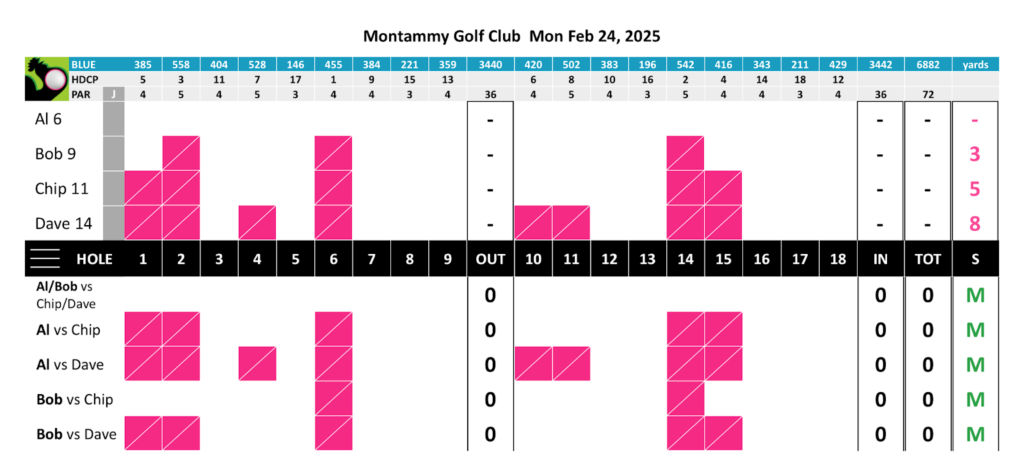
Nassau game, team and indies. Stroke holes in pink, let’s go!
Matches – track a wide variety of games, with match score displayed right on the scorecard
Scoring – seamlessly enter score and junk points; handles max score adjustment for net double bogey
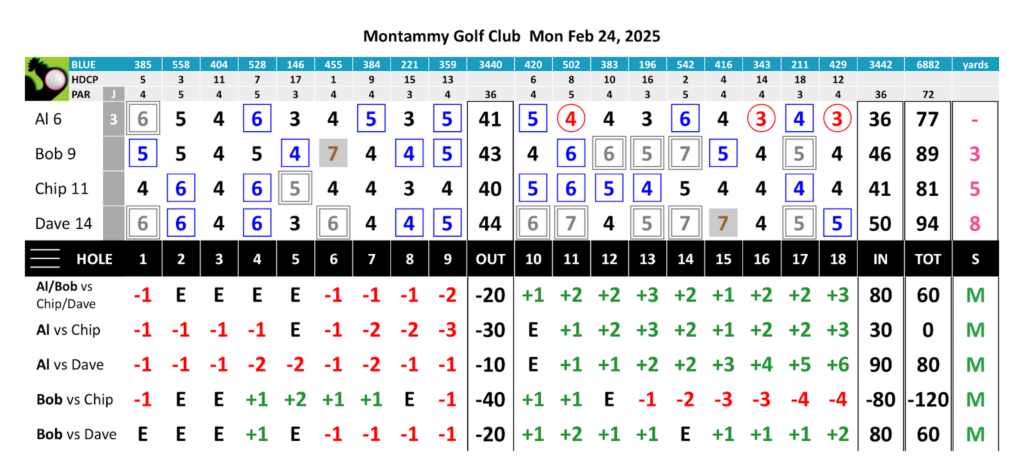
Match score (below black ribbon), hole by hole
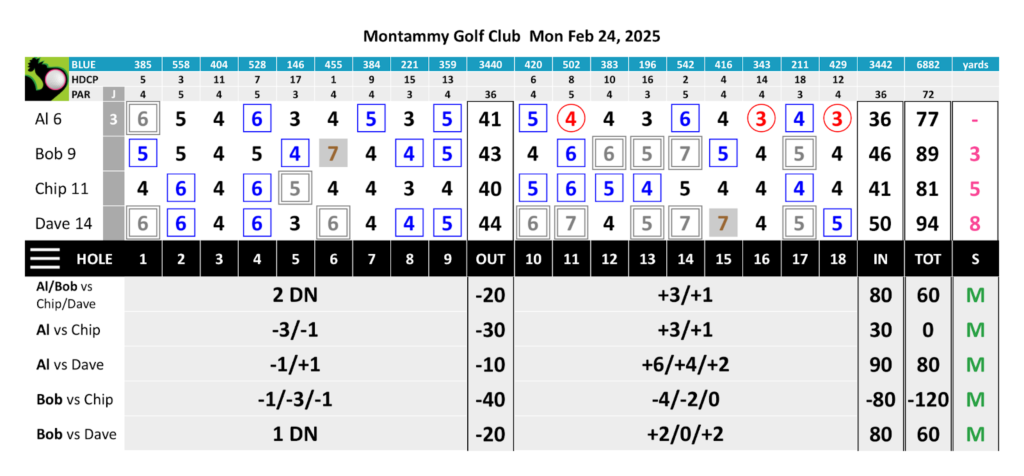
Match score showing press notation
Results – instantly tallies damages along with match recaps. Keeps a permanent record and allows comparison vs your own self-defined golf community
Last leg to finish – score posting from the app!
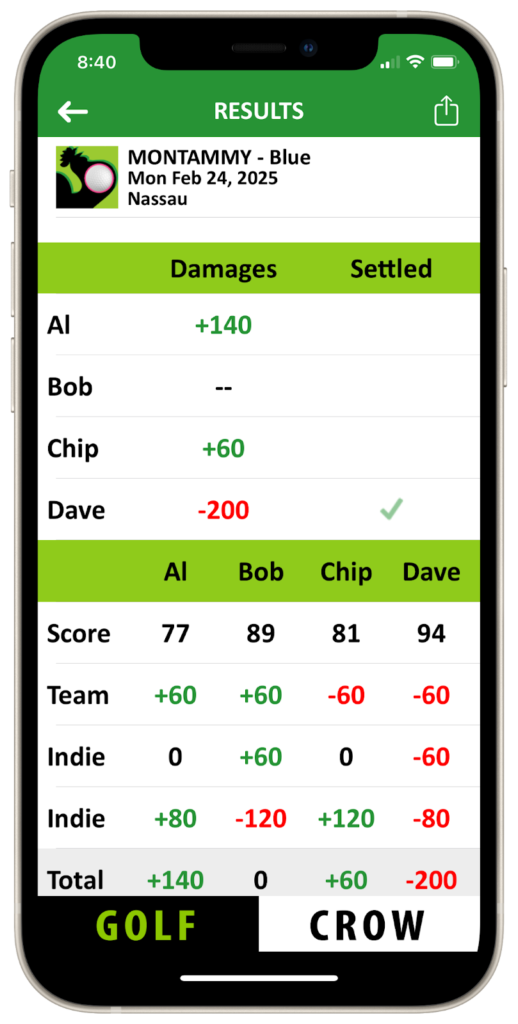
Scoring Results w/Damages, easy peasy
While clearly apparent that Golf Crow automates golf scorekeeping – it’s considered the reference among groups employing it (with hapless die hard pencil pushers always asking where matches stand) – over time a bigger benefit is knowing that virtually every round for the past several years is right here at my fingertips. My golf memory – who I played with, where, when, and how everyone did that day. The milestones, the few times I broke 80, the first time my son beat me, the rounds at Arcola, Bayonne, Bethpage, Wykagyl and other tracks, illustrious or ordinary. A vital, enduring cache of your all-time favorite activity, that’s where Golf Crow truly shines bright and adds lasting value.
Thank you for reading!
Share & follow
For inquiries, please contact:
Email – strokes@golfcrow.com
Instagram – @golfcrowapp
Website – www.golfcrow.com
YouTube – Coming soon!
Appendix – Match Score
Notation (18 holes)
Round ends after hole:
18 – 2UP, 2DN, 1UP, 1 DN, EVEN (tied, may go to extra holes)
17 – 2 & 1, 3 & 1 close match
16 – 3 & 2, 4 & 2 pretty close
15 – 4 & 3, 5 & 3 not that close
14 – 5 & 4, 6 & 4 entering beatdown territory,
13 – 6 & 5, 7 & 5 decent handicap adjustment
12 – 7 & 6, 8 & 6 most likely follows
11 – 8 & 7, 9 & 7 ugly
10 – 10 & 8, 9 & 8 wipeout, ouch, no holes won by one side
“Dormie” – a match is dormie when one side is ahead by the same number of holes as are left to play. Must win situation for the side that is down. For the side that is ahead a tie or win on any of the remaining holes ends the match. From the French/Latin “dormir”, meaning to sleep.
